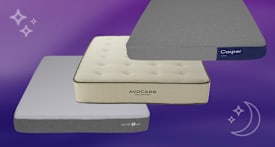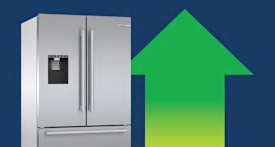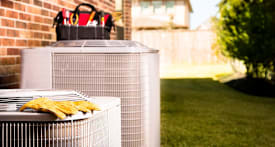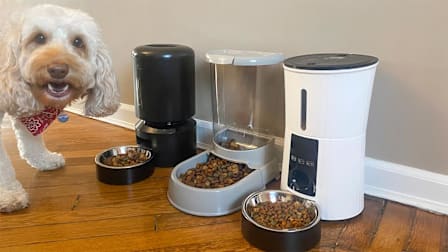What’s Really in Your Dog’s Food?
CR tested 58 dog foods from brands including Blue Buffalo, Hill’s Science Diet, and Purina for key nutrients and dangerous contaminants. Here's what we found.
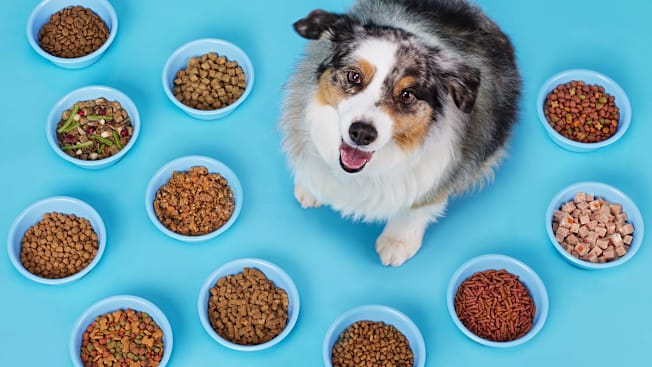
First, the good news: We did not find widespread or dangerous problems in the samples of dog food that we tested.
But our findings did make it clear that not all dog food is made equal. While most products did well when it came to meeting recommendations for nutrients like fat, protein, vitamin D, and copper, we still found significant variation in levels of these nutrients, making some foods a better fit for specific dogs than others. And we did find listeria, a harmful bacteria, in a handful of samples.
When choosing a dog food, of course, you can and should talk to your vet. But you may have to choose something before you get in for an appointment, or their answer may still leave you choosing between several options. And even if you’re a careful reader of human food labels, you might not know what you’re looking for when it comes to dog food. (What are “crude protein min” and “crude ash” anyway?)
Ads you’ve seen or the packaging itself alone are not reliable ways to compare your options, especially when choosing among dozens of bags and cans in a store—or the hundreds of kibbles, subscriptions services, and raw pet foods available online.
And though many dogs will happily eat table scraps or just about anything, your pet does have specific nutritional needs.
Your Guide to the Best Pet Products
Testing for Contaminants
CR’s scientists looked for contaminants that have led to dog food recalls within the past five years, including several aflatoxins and salmonella and listeria bacteria.
Some of these contaminants can harm or kill dogs. Certain pet foods contaminated with aflatoxins were recalled in 2020 and 2021 after they were linked to more than 110 dog deaths. Salmonella and listeria can sometimes affect pets, causing symptoms including diarrhea and vomiting. But these bacteria, a common cause of food poisoning, can also spread to humans who handle contaminated dog food or touch surfaces exposed to contaminated food, and cause severe symptoms and, in vulnerable populations, even death.
We did not detect salmonella bacteria in any of the 174 samples (three of each product) we tested. We detected aflatoxins in only one dog food, and at an average aflatoxin concentration of 1.8 parts per billion (ppb) across the three samples. That’s well under the 20 ppb "action level” above which the Food and Drug Administration—the federal agency charged with oversight of both human and pet food—would consider taking action against a potentially harmful product.
But we did detect listeria in four out of the 174 samples. We found Listeria monocytogenes, the type of listeria bacteria that is known to cause illness, in one sample of Raw Bistro’s Free Range Chicken Entrée and one sample of Viva for Dogs Ground Beef meal—both frozen raw dog foods. The other two samples of Viva for Dogs Ground Beef raw meal we tested contained Listeria innocua, which does not typically cause sickness but is sometimes considered an indicator of the potential presence of harmful listeria bacteria. Viva Raw recalled five products in July 2024 for Listeria monocytogenes contamination, though the list of recalled products did not include the product we tested.
We notified the FDA of our findings. An agency representative said they’d passed our findings to their surveillance and compliance teams.
In response to questions from CR, Raw Bistro said its internal testing of the batch of Free Range Chicken Entrée we tested did not indicate contamination, and that the product has since expired and is no longer in circulation.
A Viva representative told CR that the products we tested were past their shelf life and no longer in warehouses. “Since your purchase of these samples over a year ago, we have continued to evolve our systems with more robust finished product testing, and the application of pathogen eliminating probiotics in addition to our antimicrobial lactic acid spray,” the representative said.
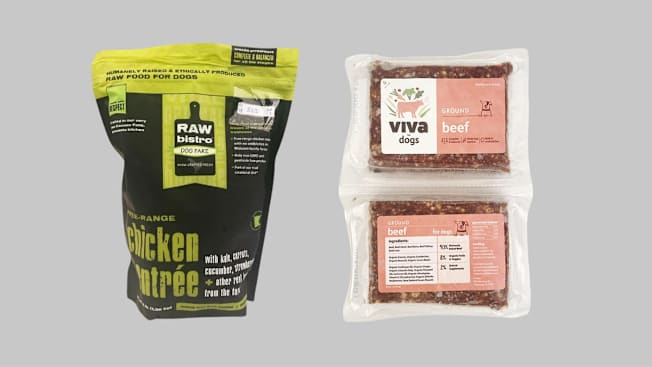
Photos: Consumer Reports Photos: Consumer Reports
What Nutrients Do Dogs Need Anyway?
Our testers looked at levels of certain important nutrients for dogs. Dogs that are different breeds and ages can have dramatically different nutritional needs. But there are some baseline recommendations for certain nutrients in standard dog foods, set by the Association of American Feed Control Officials (AAFCO). Several of the things we looked at must be listed on current dog food labels, such as protein, fat, and fiber. We tested for certain other important minerals and nutrients, like copper and—in cases where it was listed on labels—vitamin D.
We looked to see whether levels of these nutrients matched guidelines for minimum or maximum nutrient levels set by AAFCO. Every year AAFCO publishes a handbook with guidelines based on what research indicates will fulfill a dog’s nutrient requirements at various stages of life.
A cautionary note: Your dog may have nutritional needs that are more specific than these guidelines, or even may need foods with different levels of certain nutrients (see “What’s Right for Your Dog,” below). But if your veterinarian has not made specific nutritional recommendations, dog foods that meet the standard AAFCO guidelines are a good place to start, says Sandra Faeh, DVM, president of the American Veterinary Medical Association (AVMA).
Here’s why the nutrients we looked at are essential, and how much of each they should get:
Protein provides amino acids that dogs cannot synthesize unless they’re getting them from food. These serve many functions, including forming bodily tissues like muscles and organs and making it possible for animals to make glucose for energy, making protein critical for animals in all stages of life, according to a 2006 report (its latest) on the nutrient requirements of dogs and cats from the National Research Council. Foods for adult dogs that are not lactating or pregnant should contain at least 18 percent protein, while foods for puppies and pregnant dogs should contain at least 22.5 percent protein, according to AAFCO.
Fat is a primary energy source for dogs, and also provides fatty acids that are essential to skin and fur health, according to the NRC report. Foods for adult dogs should have at least 5.5 percent fat, and foods for puppies or pregnant dogs should have at least 8.5 percent fat, according to AAFCO. Dogs can adapt to and thrive on a wide range of fat concentrations, according to the NRC. Though too much fat (and thus too many calories) can lead to obesity, there is no recommended maximum fat level in dog foods.
Fiber appears to play a role in digestive health for dogs. There is currently no AAFCO recommended minimum or maximum fiber level. Dry foods typically contain between 2.5 and 4.5 percent fiber, according to the NRC report. Foods meant to provide a reduced calorie diet may have 9 or 10 percent fiber because more fiber may help dogs feel fuller longer.
Vitamin D is important for a range of basic biological functions, including muscle contraction and blood clotting, and helps dogs regulate the balance of minerals, such as calcium and phosphorus, that they need for bone health. And unlike people, dogs can’t synthesize significant amounts of vitamin D from sun exposure through the skin; they get it through food. AAFCO’s guidelines state that foods should contain between 500 and 3,000 International Units of vitamin D per kilogram of food. Excessive amounts of vitamin D can be dangerous and lead to kidney failure and death. One product we tested did have vitamin D levels significantly above the recommended range: Pedigree’s Complete Nutrition Adult Roasted Chicken, Rice, and Vegetable, with an average of 14,283 IUs per kg. (CR passed the findings to representatives of the FDA, who said they’d alert their compliance team.) After this story was published, Pedigree responded to CR’s earlier request for comment with this statement: "Following a thorough review of the single 2023 Pedigree product batch referenced by Consumer Reports, we can confirm that our products are safe. All raw material and production records show this 2023 Pedigree product batch to be in compliance with our high internal safety standards as well as FDA and AAFCO specifications, inclusive of independent and internal checks of vitamin mixes and Vitamin D testing."
Another product, Stella & Chewy’s Dinner Patties Chewy’s Chicken, had vitamin D levels under the recommended range, with 252 IUs per kg. (Stella & Chewy’s did not respond to a request for comment.)
Copper is a key component of certain enzymes that perform a variety of important functions for dogs, and is also involved in iron metabolism, central nervous system function, and the formation of connective tissue and fur pigments. It also plays a role in the nervous system and in preventing cell damage, according to the NRC. Adult dogs should get at least 7.3 mg of copper per kilogram of dog food, while puppies and pregnant dogs should have foods with at least 12.4 mg/kg of copper, according to AAFCO.
But there is a bit of controversy about copper: Some researchers argue that current minimum levels are too high. That’s in part because certain dog breeds are particularly sensitive to copper and may be prone to liver toxicity due to copper exposure. Susceptible breeds include labrador retrievers, doberman pinschers, Bedlington terriers, and West Highlight White terriers. In addition, many experts agree there should probably be an upper limit to copper but have not yet reached a consensus on what that limit should be, says Maryanne Murphy, PhD, DVM, a veterinary nutritionist and clinical associate professor of nutrition whose work focuses on dog and cat nutrition at the University of Tennessee. If your pet belongs to a copper-sensitive breed, talk to your vet about finding an appropriate food, suggests Faeh.
There are a few other things you might see listed on a dog food label. These include ash, the main source of 11 minerals that dogs need, and moisture level, the water content of food—neither of which have official requirements in the AAFCO nutrient guidelines. (Members can access the chart with our full findings below.)
A Confusing Landscape
Pet food is subject to multiple layers of regulation in the U.S. The Food and Drug Administration monitors pet foods for safety and for certain label claims. It conducts investigations and can issue recalls for contaminated food. But most states regulate pet food through their own agriculture agencies, which decide independently whether they are going to adopt the annual AAFCO recommendations for food directly or add any amendments. (AAFCO members all come from state, national, or international agencies that enforce regulations on animal food.) State feed control veterinarians also may run checks on a product if they see signs of a problem with it, Murphy says. Each state also approves or rejects specific labels on pet foods, which may lead to some variation from state to state.
Right now, AAFCO and state agencies are working on a major overhaul of pet nutrition labels. The changes are supposed to make the labels significantly easier to understand and more like those on human food, says Eric Boring, PhD, the CR chemist who co-led our dog food testing. But they’re expected to take time. The Pet Food Label Modernization project began in 2015; and in 2023 AAFCO approved the new labeling guidelines, which the organization published in its 2024 annual publication, calling for a six-year implementation period to allow states and brands to adapt to the changes.
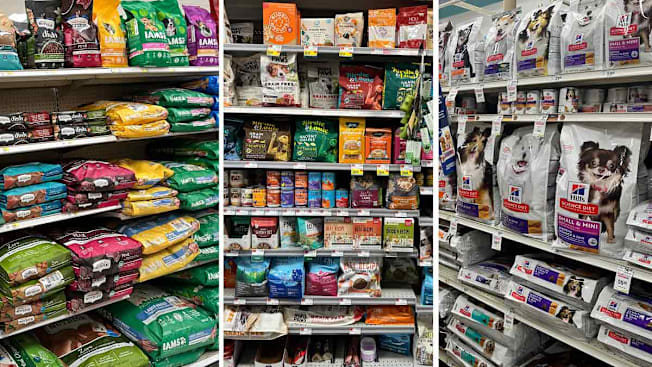
Photos: Consumer Reports Photos: Consumer Reports
What’s Right for Your Dog?
Standard recommendations don’t match the nutritional needs of every dog, which is why consulting your veterinarian is so important. For example, some very active adult dogs might thrive on higher fat levels, while dogs with certain health conditions might benefit from levels even lower than the recommended minimum amount, says Faeh, of the American Veterinary Medical Association.
Still, experts we spoke to offered some broadly applicable tips on selecting a dietary plan for your pet.
Start with the basics. If you find yourself rushing out to a grocery or convenience store because you ran out of dog food and need something quickly, choose a food with a label saying it provides a “complete and balanced” diet and meets AAFCO recommendations that are appropriate for your pet’s lifestage, says Faeh. For example, labels may include a statement saying the food is “formulated to meet the nutritional levels established by the AAFCO Dog Food Nutrient Profiles” for dogs in a particular life stage, such as "adult maintenance” for grown dogs and “growth and reproduction” or “all life stages” for puppies and pregnant or lactating dogs. Labels may also read “Animal feeding tests using AAFCO procedures substantiate that [the product] provides complete and balanced nutrition” for a particular life stage; or that the product “provides complete and balanced nutrition for [the life stage] and is comparable to a product which has been substantiated using AAFCO feeding tests.”
Foods that meet these standards won’t necessarily be a perfect food for your dog, but they’re a good place to start. In our testing, most foods did a good job meeting at least these basic standards. There are other foods that may be labeled as supplemental foods or treats, which are fine to give your dog in moderation, but should not be the majority of your dog’s diet.
Don’t overdo treats. The vast majority of dog owners give their dogs too many treats, Murphy says. In a dog’s diet, 90 percent of calories should come from meals that comprise a complete and balanced diet—and only 10 percent from treats, which do not need to meet AAFCO or other nutritional standards. To make sure you don’t overdo it, pay close attention to labels when buying treats: A 30-calorie treat may be more appropriate than a 120-calorie one, especially for a small dog.
Know your dog’s specific needs. There are plenty of reasons why the food that’s right for one dog isn’t the right fit for another. For example, Murphy says, growing dogs are going to need a puppy food. Owners of puppies whose adult weight is expected to exceed 70 pounds should look for foods specifically labeled as supporting growth of large-sized dogs, which cannot have more than a certain amount of calcium, according to AAFCO. Dogs that are gaining too much weight or have a health condition like pancreatitis might need an especially low-fat diet, Faeh says. As mentioned above, owners of copper-sensitive breeds should look into brands or prescription foods that have low copper. And if your dog has an allergy to a specific protein, such as a poultry allergy, you may want to be sure you get a food that’s not made in a factory where that protein is used, Faeh says, to avoid cross-contamination. (You could look to see whether the label says that other foods are made in the same factory or ask the company directly, or you may need to get a prescription food.)
Don’t make a change for no reason. You’ll want to change your dog’s diet if, for example, it’s not growing sufficiently or is gaining too much weight, Murphy says—issues your vet will be on the lookout for during regular checkups. And you’ll want to switch from a puppy food to a maintenance food when your dog is fully grown, she says. (While “all life stages” diets are marketed as appropriate for puppies and adult dogs, Murphy says these are basically puppy foods and probably aren’t the best choice for adult dogs.) But beyond this, once you’ve honed in on a diet that is working for your pet, you don’t need to change it unless you have a good reason, she says. There’s no one set meaning for “senior diet,” for example, and that’s not something your dog will necessarily need.
Be wary of raw food and other trendy diets. While a number of new feeding services and dietary options have emerged in recent years, these aren’t necessarily things you should adopt, experts say. The AVMA does not recommend raw food diets, and is concerned about the risks these carry for bacteria and parasites that can harm pets or people, Faeh says. (Both samples in which CR found listeria were raw food products.) The organization recommends feeding dogs foods that have been cooked or pasteurized to reduce the risks of pathogens.
You should also be cautious about adopting a home-cooked diet for your dog, she says. Even though a home-cooked meal comes from a place of love, you should confirm that your vet agrees that a home-cooked diet is adequately balanced, she says—it’s hard to be sure you’re delivering all the nutrients a dog needs. And if you do go that route, “cook the meat,” she says.
Other options like grain-free diets have most likely emerged for marketing reasons, Murphy says, “largely for the idea of wanting to feed a dog like they were a wolf out in the wild.” While some dogs might benefit from grain-free foods, she says, there’s no specific reason a dog would need a grain-free diet, and plenty of research has shown that dogs digest grains well.
Do your research. To calculate your dog’s calorie needs, Murphy suggests looking at the Pet Nutrition Alliance’s online calorie calculator.
And beyond reviewing CR’s chart below, guidelines from the World Small Animal Veterinary Association can also help you evaluate different dog food brands. These tips include checking to see whether a brand employs a nutritionist or trained formulator, meets the guidelines of AAFCO or its European counterpart (FEDIAF), has studies evaluating the food, displays a label identifying its food as a “complete” diet, and matches the needs of your individual pet. WSAVA also advises seeing whether you can contact the company to ask questions, and investigating who actually makes the food—is it the company itself or a third-party supplier? (A company likely has more control over a factory it owns itself.) The Pet Nutrition Alliance collects and publishes much of this information in a free annual report. But companies should offer information like this online or have a contact number where you can ask, Murphy says: “If you can’t get answers or aren’t comfortable, you have so many other options.”
CR’s Findings on 58 Dog Foods
We tested foods from Barf, Bil-Jac, Blue Buffalo, Bravo, Cesar, Freshpet, Hill’s, Iams, Instinct, JustFoodForDogs, Kibbles ‘n Bits, Kirkland Signature, Northwest Naturals, Nulo, Open Farm, Pedigree, PetPlate, Portland Pet Food Company, Purina, Rachael Ray, Raw Bistro, Raw Wild, Retriever, Stella & Chewy’s, Ultimate Pet Nutrition, Vital Essentials, Viva, and We Feed Raw. The products were purchased between December 2023 and May 2024, and we tested three samples of each in April and May 2024. (We tested variety packs by analyzing the nutritional content of all the foods in the pack mixed together.)
In the chart below, we included CR’s test results for protein, fat, vitamin D, and copper. If a food missed an AAFCO nutrient guideline, that’s marked with a red X. We also included our results for fiber—which is listed on dog food labels—but there is no recommended level for that nutrient. We tested foods for vitamin D only if it was listed on the label; if it wasn’t, the vitamin D column reads "N/A" for not applicable.
This isn’t a ranking of the best dog foods out there. But it enables consumers to compare the nutritional composition of various foods—and may be a useful tool when you’re talking with your vet about the right food for your pet. Be aware however, that levels of certain nutrients or minerals, like copper, could fluctuate.
Foods marked with a red diamond tested positive for listeria.




